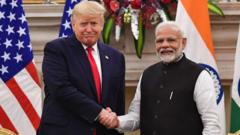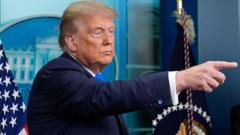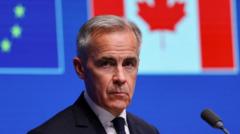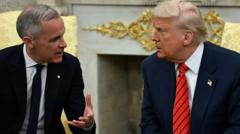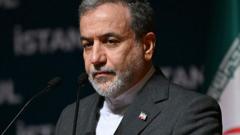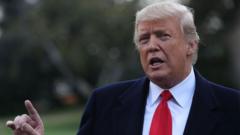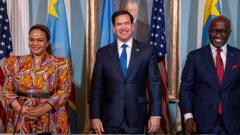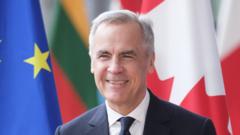The imposition of tariffs is expected to raise production costs and car prices, complicating the already tumultuous auto industry landscape.
Car Parts Tariffs Spark Industry Uncertainty in the US
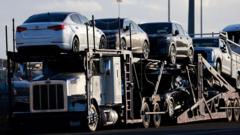
Car Parts Tariffs Spark Industry Uncertainty in the US
New 25% import tax on key automotive components takes effect amidst fluctuating market conditions.
In a significant turn of events for the automotive sector, the United States has enacted a 25% import tax on crucial components such as engines and transmissions. This new tariff, which comes on the heels of a similar tax on vehicles that began last month, aims to encourage car manufacturers to boost production within US borders. However, the timing of the implementation raises concerns, as it follows President Donald Trump’s recent decision to ease some tariff measures in response to industry apprehensions.
Industry analysts predict that while some companies may respond to the new tariffs by increasing production domestically, such moves could come at the cost of offshoring jobs and production capabilities. Historically, nearly 50% of cars sold in the US are imported, and initial reports indicate that the tariffs may lead to higher manufacturing costs for companies, which could ultimately translate into inflated prices for consumers.
General Motors and Ford, two leading automotive firms, reported substantial sales growth amid rising sales, likely influenced by fears over potential price hikes. Nonetheless, GM anticipates incurring up to $5 billion in added costs this year due to the tariffs, with a significant portion of that arising from vehicles manufactured overseas, particularly in South Korea. The company has shifted its forecast from a predicted decline in vehicle prices to expectations of a nominal increase of 1%.
The uncertainties surrounding these tariffs prompted some automakers, including Stellantis, to retract their financial guidance. Stellantis CFO Doug Ostermann acknowledged the volatility of the situation, emphasizing the heightened unpredictability of the market. Proponents of free trade argue that while these tariffs are intended to bolster domestic manufacturing, they could inadvertently lead to an escalation in costs along the supply chain.
In response to industry feedback, Trump has initiated changes to the tariff structure, including exempting certain car parts produced in Canada and Mexico under a longstanding free trade agreement. Notably, manufacturers importing vehicles from these two countries will not face tariffs on the US-made components within those cars. Analysts indicate that these adjustments may provide some relief, yet the overarching impact of the tariffs still poses a formidable challenge.
Automakers are already exploring strategies to offset the incurred costs. GM has notably ramped up production of trucks at its Indiana facility while reducing output in Canada. Similarly, Mercedes-Benz has voiced its capability to scale production at its Alabama factory in light of the new tariff regime.
Labor experts caution that while there may be announcements of expanded domestic production in the coming months, the establishment of new factories is unlikely, given the significant financial commitment required and the current market’s instability. Looking ahead, the administration is rumored to be negotiating new trade agreements with South Korea and Japan, further adding to the evolving landscape of the automotive industry.
The final repercussions of these tariffs remain to be fully realized, and as pointed out by experts, the current economic climate may change if adverse effects become apparent. “Everything is pretty good now,” observed labor analyst Art Wheaton, suggesting that the true impact of the transition has yet to unfold.
Industry analysts predict that while some companies may respond to the new tariffs by increasing production domestically, such moves could come at the cost of offshoring jobs and production capabilities. Historically, nearly 50% of cars sold in the US are imported, and initial reports indicate that the tariffs may lead to higher manufacturing costs for companies, which could ultimately translate into inflated prices for consumers.
General Motors and Ford, two leading automotive firms, reported substantial sales growth amid rising sales, likely influenced by fears over potential price hikes. Nonetheless, GM anticipates incurring up to $5 billion in added costs this year due to the tariffs, with a significant portion of that arising from vehicles manufactured overseas, particularly in South Korea. The company has shifted its forecast from a predicted decline in vehicle prices to expectations of a nominal increase of 1%.
The uncertainties surrounding these tariffs prompted some automakers, including Stellantis, to retract their financial guidance. Stellantis CFO Doug Ostermann acknowledged the volatility of the situation, emphasizing the heightened unpredictability of the market. Proponents of free trade argue that while these tariffs are intended to bolster domestic manufacturing, they could inadvertently lead to an escalation in costs along the supply chain.
In response to industry feedback, Trump has initiated changes to the tariff structure, including exempting certain car parts produced in Canada and Mexico under a longstanding free trade agreement. Notably, manufacturers importing vehicles from these two countries will not face tariffs on the US-made components within those cars. Analysts indicate that these adjustments may provide some relief, yet the overarching impact of the tariffs still poses a formidable challenge.
Automakers are already exploring strategies to offset the incurred costs. GM has notably ramped up production of trucks at its Indiana facility while reducing output in Canada. Similarly, Mercedes-Benz has voiced its capability to scale production at its Alabama factory in light of the new tariff regime.
Labor experts caution that while there may be announcements of expanded domestic production in the coming months, the establishment of new factories is unlikely, given the significant financial commitment required and the current market’s instability. Looking ahead, the administration is rumored to be negotiating new trade agreements with South Korea and Japan, further adding to the evolving landscape of the automotive industry.
The final repercussions of these tariffs remain to be fully realized, and as pointed out by experts, the current economic climate may change if adverse effects become apparent. “Everything is pretty good now,” observed labor analyst Art Wheaton, suggesting that the true impact of the transition has yet to unfold.

